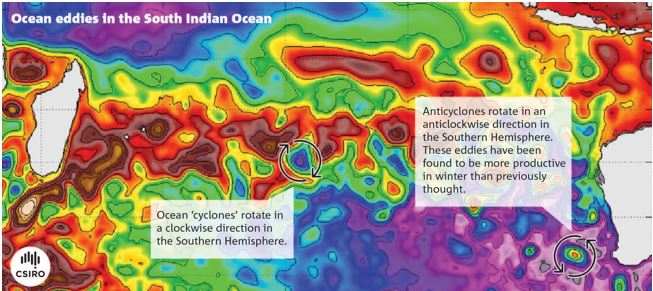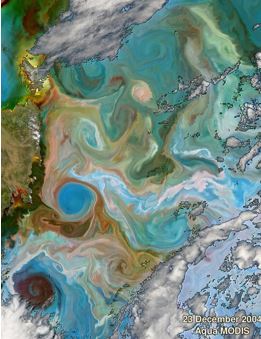Conventional wisdom on how the largest ecosystems in the ocean access nutrients to fuel their productivity has been questioned in a paper published in Science Advances.
The CSIRO Oceans and Atmosphere and University of Queensland research team has used satellite measurements and biogeochemical modelling to show that swirling currents of water called ‘eddies’ behave differently to previously thought in the extensive subtropical gyre ecosystems that make up two thirds of the surface ocean.
One of the paper co-authors is Professor Anthony Richardson of UQ’s School of Mathematics and Physics, and CSIRO Oceans and Atmosphere.
“The take-home message here is that this paper overturns conventional wisdom about productivity in the oceans,” Professor Richardson said.
The paper by Francois Dufois et al. has demonstrated that in winter, when the subtropical ocean (between 30° North and 30° South) is most productive, anti-cyclonic eddies undergo more mixing that can increase inputs of nutrient, overturning an earlier understanding that these eddies were the ocean equivalent of ‘barren deserts’.
Just like weather systems, oceanic eddies can flow in both a clockwise and anticlockwise fashion. And like in weather systems, these are described as cyclonic and anti-cyclonic systems (which rotate in opposite directions in each hemisphere). Previous studies had suggested that, for most parts of the ocean, only cyclonic eddies show increased primary productivity.
CSIRO Principal Scientist Dr Nick Hardman-Mountford said: “This study fundamentally changes our view of productivity in ocean eddies. Throughout the vast areas of the subtropical oceans, we now find that it is usual for anti-cyclonic eddies to have higher productivity”. The finding has significant implications for understanding the biological carbon pump, a major ocean process that sucks carbon dioxide from the atmosphere and into the ocean.
The growth of microscopic marine algae, termed phytoplankton, can be measured by satellites which view chlorophyll (a proxy for productivity) at the sea surface. This growth is directly related to the amount of nutrients available for photosynthesis in the sunlit upper ocean.
“Increased nutrient availability in the ocean can fuel the growth of phytoplankton, known as primary productivity, which is the basis of the marine food web. Everything from microscopic zooplankton to fish, seabirds, sharks and whales rely on primary productivity. When the nutrient-rich deep-water is mixed with the ocean’s upper layers, hungry phytoplankton that live in the light-soaked top 100 metres consume it, accelerating photosynthesis, leading to more algal growth, much of which sinks deeper in the ocean.” said Dr Hardman-Mountford.
This natural carbon sequestration may have a mitigating effect on climate change.
Co-author and CSIRO Senior Research Scientist Dr Richard Matear said: “Oceanic eddies could play a role in global climate change mitigation, especially if human induced climate forcing enhances eddy activity as other studies have suggested.”
To test this new found understanding Dr Matear, Dr Hardman-Mountford and colleagues will now use data from BioArgo ocean robots that they have deployed in subtropical eddies to record nutrient changes and phytoplankton growth as they happen.
“This work emphasises the need to use ocean models that resolve eddies in climate change simulations”, Dr Matear said.
“Doing this could vastly improve our understanding of the Earth system.”
No longer will anti-cyclonic eddies be thought of as ocean deserts but areas of enhanced productivity for marine life.


Key Contacts
Media – Chris Gerbing, CSIRO – +61 418 800 778 – chris.gerbing@csiro.au
Science – Nick Hardman-Mountford - +61 477 322 139 – nick.hardman-mountford@csiro.au



